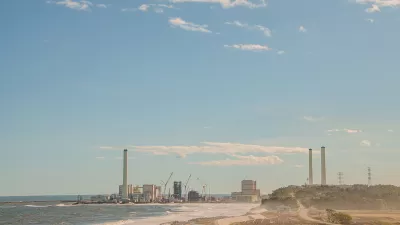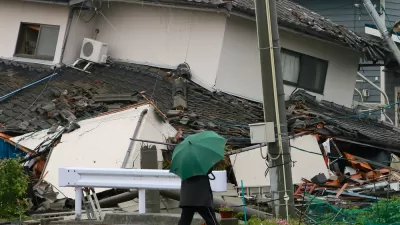Having just returned from a United Nations-led tour of disaster-ravaged areas of Japan, Warren Karlenzig reports on efforts across the region to rebuild along smart growth and green economic development models.
With the one-year anniversary of the Tōhoku earthquake and tsunami and Fukushima Daiichi nuclear accident fast approaching, Karlenzig recently toured six tsunami-damaged communities and two radiation-impacted cities in Northern Japan as part of a UN Center for Regional Development (UNCRD) fact-finding mission, one of the first (if not the first) from outside the three affected prefectures to meet with local leaders on reconstruction and post-disaster management planning.
Although the full rebuilding effort will not begin for several years due to a number of factors (unstable ground, waste removement, etc.), many communities have already submitted reconstruction plans including land use schemes to the national government, and Karlenzig points to the plans of two particular tsunami-ravaged cities that stand out for being smart growth models.
In Ishinomaki,a pre-tsunami city of about 160,000 which had the most tsunami deaths of any city, "has a plan to virtually wipe clean its remaining 'ghost' downtown to create a mixed-use residential-commercial zone that will be 2-3 times as denser than before," writes Karlenzig. He also sees transit-oriented redesign as a strategy being utilized to keep and attract younger citizens.
With the country scrambling to replace the 25-30% of the nation's energy supply that came from now mostly shuttered nuclear facilities, quickly growing the country's renewable energy production will be of importance nationwide, and as the basis for developing the economies of disaster-ravaged areas.
"Rikuzentakada, a city of 22,000 (2,000 died in the tsunami), is making plans to make 'new energy' a key part of its redevelopment vision. This city which was reported to have been "wiped off the map," by 65-foot (19.2 meter) waves is today pursuing national government subsidies and private investments to create large-scale distributed generation of renewables, including PV solar, land biomass (wood), marine biomass and offshore wind."
Later this month, Karlenzig's delegation will work with UNCRD to develop recommendations based on their visit.
FULL STORY: Japan's Green Renewal? After the Disasters UN Tour

Alabama: Trump Terminates Settlements for Black Communities Harmed By Raw Sewage
Trump deemed the landmark civil rights agreement “illegal DEI and environmental justice policy.”

Study: Maui’s Plan to Convert Vacation Rentals to Long-Term Housing Could Cause Nearly $1 Billion Economic Loss
The plan would reduce visitor accommodation by 25% resulting in 1,900 jobs lost.

Planetizen Federal Action Tracker
A weekly monitor of how Trump’s orders and actions are impacting planners and planning in America.

Federal Homelessness Agency Places Entire Staff on Leave
The U.S. Interagency Council on Homelessness is the only federal agency dedicated to preventing and ending homelessness.

Restoring Northern India’s Himalayan ‘Water Temples’
Thousands of centuries-old buildings protect the region’s natural springs and serve as community wells and gathering places.

Milwaukee to Double Bike Share Stations
Bublr Bikes, one of the nation’s most successful, will add 500 new e-bikes to its system.
Urban Design for Planners 1: Software Tools
This six-course series explores essential urban design concepts using open source software and equips planners with the tools they need to participate fully in the urban design process.
Planning for Universal Design
Learn the tools for implementing Universal Design in planning regulations.
Caltrans
Smith Gee Studio
Institute for Housing and Urban Development Studies (IHS)
City of Grandview
Harvard GSD Executive Education
Toledo-Lucas County Plan Commissions
Salt Lake City
NYU Wagner Graduate School of Public Service




























